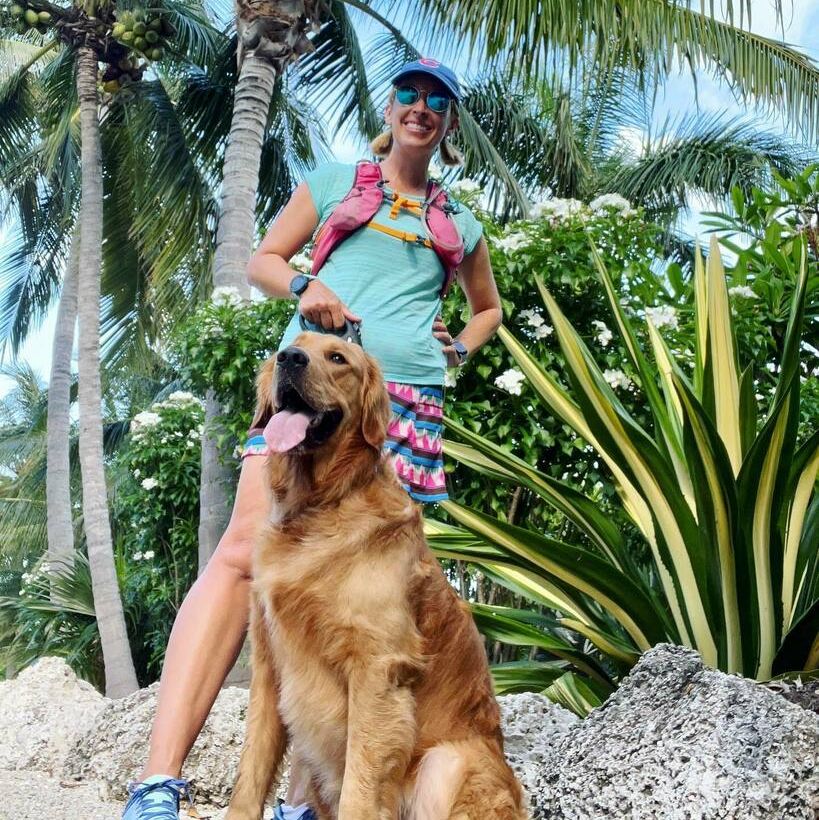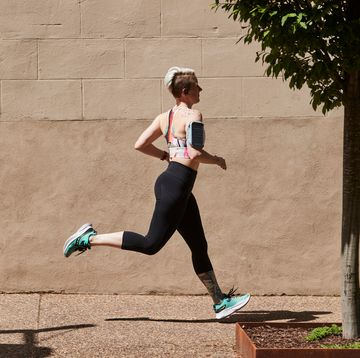I am not one of those people who has a love/hate relationship with running. I love it purely and wholly. It feels like my body was made to do it. I love being outside and moving, and the rush of endorphins is great. If I could run all day, I would.
I started running ultramarathons to give myself permission to run forever, and found that even after running 100 miles or for 31 hours, I love it.
Like all runners, though, I have days when it’s hard to get out the door. Sometimes I’m tired, and I waste hours procrastinating when it’s cold and rainy out. Fortunately, though, I have five golden retrievers and they always need walks. Even in bad weather, one will run over with enthusiasm and joy, stretching their neck toward the collar. In those cases, to delay my run would be to deny them happiness, so suddenly it’s easy to go outside.
While I can walk five dogs at once—that’s me in the top picture with Swizzle, Venkman, Hopper, Guacamole, and Chief Brody—I never run with them all together nor do I do ultra distances with them!
While I have run with two dogs at once, it’s safest to run with just one, because when I do take two, we stop more often, and they inevitably get tangled. Then my focus becomes more on dog management than running.
In The Purest Bond: Understanding the Human-Canine Connection, Stacey Colino and I explore the science behind how relationships with dogs make human lives better. Certainly, dogs help humans move more and form better relationships in their communities. Science also shows that dogs enjoy running with us, both because of how it makes them feel physically and because they get to spend time with us.
One of my favorite workouts is to take each dog out for one or two miles until everyone who wants a run has had a chance to go out.
I’ve learned a lot about running with dogs over the years, so I’m sharing my tips for how to run safely and successfully with your own four-legged friends.
5 Tips to Better Running With Your Dog
If you want to start running with your dog, start by telling your veterinarian how far and fast you run, so they can give you specific information about your dog’s ability. Once you have the go ahead, follow these five tips to make your runs more enjoyable and safe—for both you and your pup.
1. Learn Leash Skills
When I was a graduate student, I tried to take my two golden retrievers, Pi and K, for a run. Suddenly, K spotted something exciting across the street, bolted, and pulled me off the sidewalk. I hobbled home with a sprained ankle.
To avoid unexpected accidents, work on your leash skills before you start running with your dog. Sure, a dog who pulls makes uphill runs easier, but a dog who bolts for squirrels or in traffic is a risk.
You’ll know your dog has solid leash skills if they run calmly alongside you with a loose leash, and you don’t have to pull to control them. They also should have enough self control to not dart out at animals or jump at sounds.
Your dog should also respond to commands such as “stop” or “wait,” and be able to respond to your speed, rather than you having to keep up or wait for them, especially if you want to run at a consistent pace.
If you have a scent dog, you may need to separate your runs from walks where they are able to follow their nose and go at their own pace. Habits like stopping to sniff can be managed with leash training.
My dog, Guacamole, a notorious stop-and-sniff dog, knows the difference between walks and runs, based on the way I hold the leash and, obviously, my speed. It’s like a form of non-verbal communication between the two of us. Guacamole understands that he is supposed to match my pace, whether I’m running or walking and he is able to adjust himself.
Good leash discipline is also useful when you encounter others on a trail.
2. Start With Short Runs
You won’t be surprised to learn that dogs are wired to run, according to research. Aside from having four legs, research shows that dogs also have an increase in endocannabinoids (eCBs) after a run. This is one of the main neurotransmitters believed to play a role in the runner’s high.
Of course, human runs and dog runs are very different. For example, while small dogs can be good running partners, toy breeds have to take a lot of steps to keep up with humans. Dedicated runners with dogs who may not be right for running can always consider using a jogging stroller to bring their pal along with them!
Some dogs may also be better walking partners. For example, dogs with smooshed faces (“brachycephalic”) or with short limbs, such as bulldogs and corgis, can have difficulty running and be at higher risk for injury. Again, check in with your dog’s vet for advice about how far, how fast, and how frequently your dog should run.
Natural runners, such as hounds, can still vary in the distances they prefer. My golden retrievers are comfortable with around three miles, but they are not built to be long-distance runners. Huskies, herding dogs (Australian shepherd, border collies, and others), and Vizslas are all good at going for distance.
All runners should follow the 10-percent rule for increasing their distance or intensity (an increase of no more than 10 percent each week) and this rule applies to dogs, too.
Remember, though, dogs can get the same overuse injuries as people. Be on the lookout for new limps, tenderness, or hesitation, which may indicate your dog is exceeding their abilities.
3. Learn Your Dog‘s Fuel and Hydration Needs
You need water on a run that’s over a couple of miles, and your dog does, too. Consider hydration for them, too, which means carrying at least a collapsible bowl and adding enough water to your supply to share.
If you have a breed that runs long distances, bring food, such as biscuits or treats, so they can stay fueled, too. If you’re going for a long run and don’t feel like carrying your dog’s supplies, you can find harnesses with pockets so your dog can carry their own food and water (and poop bags!), which will lighten your load.
Just like humans, my dogs are often hungrier on days that they run, so I take cues from them if they need more food. It can be a little tough to tease out when they are actually hungry because of the extra activity versus their normal habit of begging for extra food, but with attention, I have learned to tell the difference. When my dogs go to the kitchen after dinner looking for snacks or extra food or if the beg more aggressively for my food, it suggests to me that I need to feed them more.
If your dog pants hard for a very long time with a bit elongated tongue or they are more lethargic than usual after a run, it may be a sign that you went too far. Watch their recovery just as you should pay attention to your own.
4. Understand the Way Weather Affects Animals
Your dog may not need as much gear as you do, but it’s important to prepare for different weather conditions.
In hot weather, be sure to check the heat of the pavement. If it feels hot to your touch, it can burn your dog’s paws. In the Florida Keys where I live, I only take my dogs for nighttime runs during hot months.
If you live somewhere cold, your dog’s paws could literally freeze to the pavement. Plus, snow may form ice balls inside their paws, and the salt used to prevent icing on sidewalks can irritate their pads. An affordable and effective solution for snow and trail running are sled dog booties, used by mushers and their dog sled teams. For road running, you can also find options with a tougher sole.
Also, pay attention to your dog’s response to the weather. Even in mild weather, dogs can get overheated on a run. Usually, they will show this with excessive panting or by simply lying down and refusing to continue. It is crucial to give them a break in these situations, even if it means gently walking home and cutting your run short.
5. Get Them Safety Gear
In 2022, we fostered a dog named Nacho for six months. He was a very energetic 18-month-old golden retriever who needed a lot of exercise. I earned two visits to the orthopedic surgeon—once for a sprained shoulder and one for a damaged finger tendon—from those runs.
Not only had we not mastered leash skills, but I also had the wrong equipment. After those doctor visits, I switched to a waist leash so I could use my whole bodyweight to control him. You will typically weigh more than your dog, so these leashes may help you control their movement. However, some dogs are stronger than their owners, and it can be hard to balance when they pull you by the waist. So test out a waist leash on a shorter distance before you go long and see how it feels.
The scariest moments I have had with dogs is when they pulled the leash out of my hands and got away from me in the dark. In addition to the waist leash, which you can’t drop, I use LED collars at night.
You can buy plastic loops and collars with embedded rechargeable LEDs, or flashing tags for their normal collars. All of these gadgets give you a visual cue about where your dog is. They also make your dog—and you!—visible to traffic and to other people.















